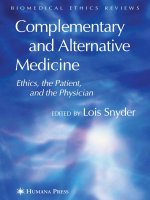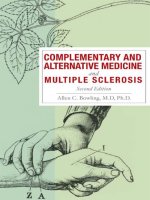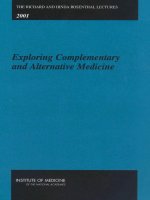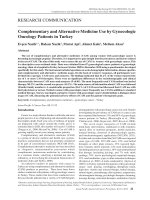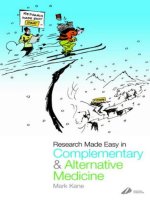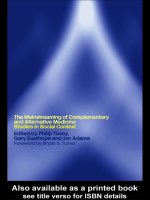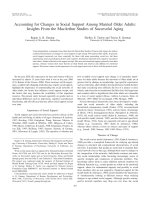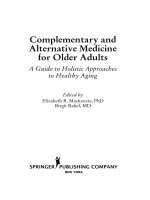Complementary and Alternative Medicine for Older Adults A Guide to Holistic Approaches to Healthy Aging ppt
Bạn đang xem bản rút gọn của tài liệu. Xem và tải ngay bản đầy đủ của tài liệu tại đây (858.65 KB, 344 trang )
Complementary and
Alternative Medicine
for Older Adults
A Guide to Holistic Approaches
to Healthy Aging
Edited by
Elizabeth R. Mackenzie, PhD
Birgit Rakel, MD
About the Editors
ELIZABETH R. MACKENZIE, PHD, has been a researcher and educator in the
field of complementary and alternative medicine for two decades. Dr.
Mackenzie completed her doctoral dissertation on health belief systems
and community-based healthcare at the University of Pennsylvania in
1994, whereupon she joined the Institute on Aging at the University of
Pennsylvania Health System and conducted research on cultural issues in
health and healthcare. As a Research Assistant Professor in the division
of geriatric medicine, she was the principal investigator of a study on aging, mental health, and prayer. Dr. Mackenzie currently teaches courses
on humanistic medicine in the School of Arts and Sciences at the
University of Pennsylvania, where she is a Senior Fellow in the Writing
Center, a Lecturer in the History and Sociology of Science department,
and an Associate Fellow of the Institute on Aging. Dr. Mackenzie is the
author of Healing the Social Body: A Holistic Approach to Public Health
Policy, numerous journal articles, and several book chapters. In addition
to her academic work, Dr. Mackenzie is a long-time student of yoga,
qigong, and body psychotherapy.
BIRGIT RAKEL, MD, earned her medical degree from the Freie University
of West Berlin, Germany in 1988. Dr. Rakel completed her internship before moving to England, where she received her General Practitioner (GP)
training. She worked as a GP in London, where she also completed a fellowship at the Royal London Homoeopathic Hospital. Dr. Rakel relocated to the U.S. in 1996, where she completed a residency and became
board certified in Family Medicine. Since 2001, Dr. Rakel has been on the
faculty of the Jefferson Myrna Brind Center for Integrative Medicine at
Thomas Jefferson University Hospital in Philadelphia PA, one of the first
academic medicine centers in North America that integrates CAM into
patient care, teaching, and research. Dr. Rakel was recently awarded a
Bravewell Fellowship, an appointment that allows her to further her
training at the University of Arizona’s Program in Integrative Medicine
under the direction of Andrew Weil, MD. She presents nationally on topics related to aging and integrative medicine.
Complementary and Alternative
Medicine for Older Adults
A Guide to Holistic Approaches
to Healthy Aging
Copyright © 2006 by Springer Publishing Company, Inc.
All rights reserved.
No part of this publication may be reproduced, stored in a retrieval system,
or transmitted in any form or by any means, electronic, mechanical,
photocopying, recording, or otherwise, without the prior permission of
Springer Publishing Company, Inc.
Springer Publishing Company, Inc.
11 West 42nd Street
New York, NY 10036
Acquisitions Editor: Helvi Gold
Production Editor: Jeanne Libby
Cover design by Joanne Honigman
Typeset by Daily Information Processing, Churchville, PA
06 07 08 09 10 / 5 4 3 2 1
Library of Congress Cataloging-in-Publication Data
Complementary and alternative medicine for older adults : a guide
to holistic approaches to healthy aging / [edited by] Elizabeth
Mackenzie, Birgit Rakel.
p. ; cm.
Includes bibliographical references and index.
ISBN 0-8261-3805-5
1. Alternative medicine. 2. Holistic medicine. 3. Older people—
Diseases—Alternative treatment. I. Mackenzie, Elizabeth R.,
1961–
. II. Rakel, Birgit.
[DNLM: 1. Complementary Therapies—methods—Aged.
2. Health Promotion—methods—Aged. 3. Holistic Health—Aged.
WB 890 C73667 2006]
R733.C65284 2006
613'.0438—dc22
2005031316
Printed in the United States of America by Bang Printing.
Contents
Contributors
Preface by Elizabeth R. Mackenzie and Birgit Rakel
Acknowledgments
Foreword by Marc Micozzi, MD, PhD
vii
xi
xv
xvii
Chapter 1
Holistic Approaches to Healthy Aging
Elizabeth R. Mackenzie and Birgit Rakel
Chapter 2
Healthy and Therapeutic Diets That Promote
Optimal Aging
Joel S. Edman
11
Chapter 3
Supplements and Herbs
Ara DerMarderosian and Michael Briggs
31
Chapter 4
Homeopathy as an Aid to Healthy Aging
Joyce Frye
79
Chapter 5
Music, Health, and Well-Being
Elaine Abbott and Kathleen Avins
97
Chapter 6
Art Therapy
Caroline Peterson
111
Chapter 7
Massage Therapy and Older Adults
Eileen Kennedy and Cheryl Chapman
135
Chapter 8
Daoist Spirituality and Philosophy: Implications
for Holistic Health, Aging, and Longevity
Amy L. Ai
149
v
1
vi
Contents
Chapter 9
Medical Acupuncture
James K. Rotchford
161
Chapter 10
The Benefits of Qigong
Kevin Chen, Elizabeth R. Mackenzie,
and Master FaXiang Hou
175
Chapter 11
Yoga: An Introduction
Robert Butera
199
Chapter 12
Ayurveda: Mother of Traditional Medicine
Mari Clements
215
Chapter 13
Meditation and Healthy Aging
Elaine J. Yuen and Michael J. Baime
233
Chapter 14
The Concept of Spiritual Well-Being and the Care
of Older Adults
Amy L. Ai and Elizabeth R. Mackenzie
271
Chapter 15
Therapeutic Gardens
Jack Carman
289
Chapter 16
The Eden Alternative: Nurturing the Human
Spirit in Long-Term Care
Sandy Ransom
299
Index
311
Contributors
Elaine Abbott, MMT, MT-BC, is a board-certified music therapist, with
over 7 years of experience working with the elderly in continuing care
retirement communities and skilled nursing facilities. She has a master’s
degree in music therapy and is currently working on her PhD in music
therapy at Temple University.
Amy L. Ai, PhD, is an associate professor of social work at the University
of Washington in Seattle and serves as a principal or co-investigator for
several large NIH-funded studies pertaining to spirituality and health,
and integrative medicine. Dr. Ai is a fellow of the National Institute on
Aging and a John A. Hartford Faculty Scholar.
Kathleen Avins, MMT, MT-BC, is pursuing her PhD in music therapy at
Temple University, where she also teaches. A board-certified music therapist who has more than 12 years of clinical experience with a variety of
populations; she is currently working with the Hospice of New Jersey.
Michael J. Baime, MD, is the founder and director of the Penn Program
for Stress Management and is clinical assistant professor at the University
of Pennsylvania Health System. He is an expert in the efficacy of mindfulness meditation–based stress management and is nationally recognized
for his adaptations of mindfulness meditation techniques for use in
widely varied settings, including schools, hospitals, businesses, and government. Dr. Baime is the University of Pennsylvania site director and coprinciple investigator of the parent grant. Dr. Baime began the practice of
meditation in 1969 and is currently a senior meditation teacher in the
Karma Kagyu lineage of Tibetan Buddhism.
Michael Briggs, PharmD, is an expert in phytomedicine in private practice and a freelance medical writer.
vii
viii
Contributors
Robert Butera, MDiv, PhD, is the director of the YogaLife Institute in
Devon, Pennsylvania. Dr. Butera is the publisher of a local holistic magazine, Yoga Living, and runs numerous educational and training programs
in the Philadelphia area. He studied classical yoga with Dr. Jayadeva and
Hansaji Yogendra at the Yoga Institute in Bombay, India, and is author
of Classical Yoga Study Guide.
Jack Carman, ASLA, is a landscape architect and the president of Design
for Generations LLC, a company devoted to therapeutic gardening. He
has over 18 years’ experience in the analysis, planning, design, and management of therapeutic outdoor environments for senior communities,
health care facilities, schools, and places of worship.
Cheryl Chapman, RN, HNC, NCTMB, is a massage therapist in private
practice in New Jersey who specializes in geriatric massage. Ms. Chapman
is a continuing education provider for the National Certification Board
for Therapeutic Massage and Bodywork (NCTMB) and has been nationally certified since 1992. She is a board member of the American Massage
Therapy Association and past president of the New Jersey chapter of
the AMTA.
Kevin Chen, PhD, MPH, is an associate professor of psychiatry in the
Robert Wood Johnson Medical School at UMDNJ, with a doctorate degree in social psychology and statistics and a master’s degree in public
health. His major research interests include research methodology, epidemiology of substance use/abuse, sociology of mental health, and medical applications of qigong and mind–body interaction. His current
research includes the study of qigong therapy for addiction, arthritis, cancer, and other health conditions.
Mari Clements, MS, DAy, is an Ayurvedic practitioner in private practice
at the Media Wellness Center in Media, Pennsylvania. Ms. Clements is a
board-certified diabetes educator, a certified Jin Shin Do acupressure
therapist, and an experienced wellness counselor. She has served as a
holistic counselor and therapist to students at Swarthmore College and
the University of Pennsylvania.
Ara DerMarderosian, PhD, is a professor of pharmacognosy and medicinal chemistry at the University of the Sciences in Philadelphia. For over
3 decades, Dr. DerMarderosian has taught and conducted research in
pharmacology and phytochemistry, and serves as the science adviser to
the Philadelphia District FDA Laboratories. He has over 100 publications
in journals and books.
Contributors
ix
Joel S. Edman, DSc, FACN, CNS, is a clinical assistant professor and clinical nutritionist at the Myrna Brind Center for Integrative Medicine at
Thomas Jefferson University. Dr. Edman is a nutritional counselor, educator, and researcher. He has 15 years of experience as a nutritionist in an
integrated medicine setting.
Joyce Frye, DO, FACOG, MBA, is an NIH-NCCAM research fellow in
the Center for Clinical Epidemiology and Biostatistics at the University of
Pennsylvania School of Medicine in Philadelphia and the president of the
American Institute of Homeopathy. Dr. Frye has been a homeopath in
private practice for many years. Her current research agenda focuses on
homeopathy and reproductive health.
Master FaXiang Hou, is the founding director of the Qigong Research
Society in Mt. Laurel, New Jersey, where he holds private consultations
and teaches a hereditary form of qigong passed down to him through his
familial lineage (Ching Loong San Dian Xue Mi Gong Fa). Master Hou
was designated a certified master by the International Qigong Science
Association. He is the author of Qigong for Health and Well-Being and
Unleashing the Power of Food.
Eileen Kennedy, MA, NCTMB, APP, CIMI, is a nationally certified massage therapist. She has additional certification in geriatric, cancer, and
mastectomy massage. Ms. Kennedy has published in numerous professional massage journals and shares a private practice with Cheryl
Chapman in New Jersey.
Marc Micozzi, MD, PhD, is a leader in the field of integrative medicine.
He is the founding editor-in-chief of the Journal of Complementary and
Alternative Medicine: Research on Paradigm, Practice and Policy. He is
also the editor of the first U.S. textbook on complementary and alternative
medicine, Fundamentals of Complementary and Alternative Medicine. In
2002, he became the founding director of the Policy Institute for
Integrative Medicine in Philadelphia and Washington, DC, working to
educate policymakers, the health professions, and the general public
about integrative medicine.
Caroline Peterson, MA, ATR, is a registered art therapist and mindfulness
meditation–based stress reduction teacher with the Myrna Brind Center of
Integrative Medicine at Thomas Jefferson University in Philadelphia. Ms.
Peterson coordinates clinical research there in mindfulness-based art therapy and is also on the staff of the Wellness Community of Philadelphia,
where she leads Open Studio groups for persons with cancer.
x
Contributors
Sandy Ransom, RN, MSHP, is the director of the Texas Long Term Care
Institute in the College of Health Professions of Southwest Texas State
University in San Marcos, Texas. Ms. Ransom has published widely and
has presented nationally on innovations in nursing home care. She presented testimony to the U.S. Senate Special Committee on Aging regarding Eden Alternative outcomes and has traveled as far as Australia to
teach providers about the Eden Alternative.
James K. Rotchford, MD, MPH, is a physician in private practice in
Washington State and the founding president of the Washington chapter
of the American Academy of Medical Acupuncture. Dr. Rotchford is a
fellow of the American Academy of Medical Acupuncture, a fellow of the
American College of Preventive Medicine, and is board certified in public health and general preventive medicine. He has numerous publications
in peer-reviewed journals and edits Acubriefs, a newsletter devoted to
medical acupuncture.
Elaine J. Yuen, PhD, is a research assistant professor of family medicine
in the Center for Research in Medical Education and Health Care at
Thomas Jefferson University in Philadelphia. Dr. Yuen is a meditation
teacher in the Shambhala and Tibetan Buddhist traditions, as well as an
interfaith hospital chaplain. She is currently pursuing research in the field
of spirituality and health.
Preface
This book is a compilation of chapters written by experts in their field on
various modalities and dimensions of holistic health care and aging. We
envision the book to be a compendium of reliable and authoritative information on complementary and alternative therapies that health professionals may use as they seek to improve the health and quality of life
of those in their care.
Because the field is changing rapidly as complementary and alternative medicine translates itself into integrated medicine, and many modalities undergo scientific evaluation while others remain largely unexplored,
any book on holistic health care is but a snapshot of a moving target. A
generation ago, chiropractic was still on the fringes of acceptability,
whereas now it is considered routine in most communities. Some of the
modalities included here are well known, whereas others are more obscure.
But they are all holistic in that they address the mind, emotions, and spirit
as well as the body, and each has significance for an aging population.
It is difficult, if not impossible, to cover all holistic modalities in a
single book. CAM modalities have a way of producing new variations at
a considerable rate as practitioners experiment and recombine forms. A
comprehensive treatise on bodywork alone, in addition to covering the
myriad forms of massage (e.g., Swedish, shiatsu, deep tissue, and myofascial release), would require chapters on the Feldenkrais method, the
Alexander technique, chiropractic, Network Spinal Analysis (NSA), zero
balancing, Trager, Rolfing, craniosacral therapy, and reflexology. This is
only a partial list and does not include the growing field of body psychotherapy or modalities that use energy medicine in conjunction with
bodywork (e.g., polarity therapy). Rather than produce an encyclopedic
collection of every conceivable modality (these already exist), what we
have done here is to present an introduction to those modalities that may
be of most use in the care of the aged, and are relatively easy to integrate
xi
xii
Preface
into a conventional model of care or self-care. Most importantly, each
chapter concludes with a list of resources that the reader can use to explore the topic further. If, for example, a geriatrician is caring for a patient who expresses an interest in taking valerian for her insomnia, the
physician can refer to the chapter on herbs to learn more about it and can
gather even more information by following the resources listed in the
back, thereby gaining the ability to advise knowledgably. Or, if a social
worker is concerned about one of his clients’ mild depression, he can peruse this book for information on yoga, meditation, or acupuncture to get
a sense of what might be of help and how to access classes or practitioners.
We begin the book with chapters on nutrition, herbs and supplements, and homeopathy. These are modalities that can be integrated into
a medical practice or a program of guided self-care. Although physicians
and nurses learn more about nutrition than formerly, most of us could always use more information on the healing properties of foods, especially
as this topic relates to aging. Closely related to nutrition is the topic of
herbs and supplements. Older adults can purchase all manner of substances over-the-counter, and sales of supplements such as melatonin,
DHEA, and omega-3 fatty acids are brisk. Health care professionals who
know something about the herbs and supplements that their patients
are already taking are better equipped to deliver high-quality care, as are
those who can advise patients on what to add (or not to add) to their regimen. Despite the fact that the therapeutic mechanism underlying homeopathy is controversial and not well understood by the biomedical
community, we have included it here because homeopathic remedies are
readily available over-the-counter and easily incorporated into conventional or self-care. Properly used, they also could serve as an important,
inexpensive, and safe adjunctive therapy for many of the chronic conditions common among older adults.
The next chapters cover music, art, and massage therapies, services
that require trained practitioners. Music and art therapies are most often
found in institutionalized settings such as hospitals and nursing homes,
where they are used to complement conventional care. People typically
find massage therapists on their own, although holistic physicians frequently employ such therapists in their practices. It is one of the holistic
modalities most underutilized by older adults, with numerous possible
health benefits.
We grouped together the chapters dealing with Asian perspectives on
health and healing, chiefly Chinese and Indian. Traditional Chinese medicine and Ayurveda are complex, cosmopolitan systems rooted in millennia of research and practice in their countries of origin. We chose to give
the reader some sense of the underlying philosophy of the East, with
Preface
xiii
chapters introducing some of the most accessible aspects of these systems
(i.e., yoga, acupuncture, and qigong).
Next, we included chapters on spirituality and meditation, as well as
two chapters that pertain most closely to improving the quality of life in
long-term care. We feel that it is crucial for professionals to consistently
consider the emotional and spiritual dimensions of health, especially
when caring for persons who may be approaching the end of their lives.
This is purposefully not an “antiaging” book. In truth, the only remedy for growing older is death, for as long as we live, we age. Instead, we
view this book as a collection of information on how to age healthfully
by employing modalities that consider the whole person—body, mind, and
spirit—in their approach, thus maximizing opportunities for the older
adult to live his or her life to its fullest, as vibrant and vigorous as possible.
We hope this book will find its way into private practices, public
clinics, hospitals, skilled nursing facilities, senior centers, anywhere
health professionals are busy serving the “young-old,” the “old-old,” or
even those on the threshold of becoming “old.” Information within may
inspire doctors, nurses, gerontologists, and social workers to learn more
about integrated medicine, helping them include some of these approaches into their practices or giving them the necessary information so
that they can confidently refer their clients and patients to holistic practitioners or activities. The more we know, the better we can serve the older
adults who look to us for advice, relief, information, and care. May you
enjoy this book in excellent health.
ELIZABETH R. MACKENZIE AND BIRGIT RAKEL
Acknowledgments
Books, especially ones like this, are the product of many persons’ efforts,
and the editors would like to thank those who contributed to its completion. Obviously, the chapter authors deserve the lion’s share of thanks.
We are profoundly grateful for their expertise and their willingness to
pour their knowledge into this book.
ERM: In addition, I would like to thank Helvi Gold who initially approached me with the concept for the book and who (with her colleagues
at Springer Publishing) waited patiently while it coalesced. Birgit Rakel’s
impeccable understanding of the practice of holistic medicine has been
immensely valuable in shaping the content and contours of this book. I
am also grateful to the following friends and teachers who have deepened
my understanding of how holistic principles apply to health: Ute Arnold,
Carrie Demers, MD (of the Himalayan Institute), Master FaXiang Hou,
Bernardo Merizalde, MD, Deborah and Patrick Redmond, Suzanne
Richman (Goddard’s Health Arts and Sciences Program), and Joan
White. Finally, I would like to express my gratitude to my academic mentors David J. Hufford, PhD and Risa Lavizzo-Mourey, MD, MBA for all
their advice and help over the years.
BR: This book would not have been possible without Elizabeth Mackenzie’s
endurance, enthusiasm, and expertise. Thank you to everyone at Springer
Publishing, but especially to Helvi Gold who supported us through the
editing process. Thank you to my family and friends in Germany and the
U.S. for all their encouragement, and to Jon Kabat-Zinn, PhD and Robert
T. Sataloff, MD, DMA for inspiring me to reach beyond my limitations.
xv
Foreword
Some years ago, I was participating in a review session for the Healthy
People 2000 Report, in which national public health goals were articulated for the coming decade.
Among five “flagship” goals, there were two that literally didn’t add
up: to increase the average longevity and to increase the average number
of years of healthy life span. There was a marked discrepancy in these
goals for longevity and for healthy life span, with the latter being several
years shorter than the former. My prediction for the headline in the
Washington Post was “Government Says Alright to Be Ill the Last Several
Years of Life.”
Today, there is increasing concern that longevity not outdistance
healthy life span and increasing evidence that therapies classified as holistic, alternative, and complementary may provide benefit. Most diseases
and disorders are age-related. Age is the largest single risk factor for most
cancers and many chronic diseases.
Utilization of complementary and alternative medicine (CAM) is
widespread and increasing among adults in the United States (Micozzi,
2001). A recent survey showed that two thirds of adults show lifetime use
of CAM by age 33 (Kessler et al., 2001), Further, CAM use is highest
among post–baby boomers (7 out of 10), with only 5 out of 10 boomers
and 3 out of 10 preboomers. These trends may represent an openness to
CAM that has more to do with managing medical conditions than with
lifelong attitudes inclusive of “holistic” healing.
In addition, two thirds of health maintenance organizations offered
at least one type of alternative therapy as of 1999, (Wootton & Sparber
2003) with acupuncture, massage, and nutritional therapy the most likely
modality to be added. The best predictor of CAM use is higher education,
perhaps reflecting disposable income as well as knowledge, awareness,
and attitudes.
Regional variations are quite consistent, with such diverse areas as
South Carolina, Northern California, Florida, and Oregon all registering
in the range of one half to two thirds of respondents to a survey using
CAM (Wootton & Sparber 2003). Up to half of all clients do not tell their
xvii
xviii
Foreword
physicians, indicating that much additional work on integration of CAM
into the continuum of care is needed.
A high proportion of adults with cancer utilize CAM. Several surveys
found rates of 80% or higher. In one study, 40% of CAM users abandoned conventional care after adopting CAM. (Wooton & Sparber 2003)
For breast cancer, despite the relative effectiveness of conventional care,
CAM use was as high as 74%.
CAM use is also marked in neurological diseases, psychiatric disorders, physical disabilities, psoriasis, diabetes, and other disorders
(Wootton & Sparber, 2003). The range of CAM modalities utilized are
well reflected in the topics covered in this volume.
In addition to the management of medical conditions, CAM therapies have gained increasing attention in chronic disease prevention.
Although CAM is often thought of as more related to healthy lifestyle and
the prevention of disease, in fact, there has been more evidence about the
effectiveness of CAM in treatment. Clinical trials on CAM are increasing
in number, while prevention trials are larger, longer, more costly, more
complex, and ultimately more rare (Moon & Micozzi, 1989).
Nonetheless, the article “Vitamins for Chronic Disease Prevention in
Adults” by Fairfield and Fletcher in June 2002 in the Journal of the
American Medical Association documented the importance of nutrition
and finally provided substantiation for the role of dietary supplementation in light of the typical U.S. diet and nutrient composition of foods.
Dietary supplement use is already prevalent among older Americans. In
addition, efforts are under way to provide older Americans with dietary
supplementation by the Healthy Foundation, with support from U.S.
Senator Tom Harkin (D-Iowa) and by the Dietary Supplements for Senior
Health Program with support from U.S. Senator Larry Craig (R-Idaho),
who chaired the Senate Special Committee on Aging. In 2001, the
Committee on Aging commissioned a report on the use of dietary supplements in older Americans by the General Accounting Office. The GAO
report documented the problems associated with this practice but did not
address the evidence of benefits; the Committee on Aging has promised
to revisit the issue.
Because the interest and investment in CAM have broadened and
deepened among health professionals, policymakers, and the public, this
text is a timely addition to the literature on complementary and alternative medicine. It has been edited by two highly skilled and knowledgeable
professionals in CAM research and practice, with contributions from a
national sample of recognized experts in relevant fields. This important
topic should be given a wide audience.
MARC MICOZZI, MD, PHD
Director, Informatics Institute for
Complementary and Integrative Medicine
Bethesda, MD
Foreword
xix
REFERENCES
Fletcher, R. H., & Fairfield, K. M. (2002). Vitamins for chronic disease
prevention in adults. Journal of the American Medical Association,
287, 3127–3129.
Kessler, R. C., Davis, R. B., Foster, D. F., et al. (2001). Long term trends
in the use of CAM therapies in the US. Annals of Internal Medicine,
135(4), 262–268.
Micozzi, M. S. (2006). Fundamentals of complementary and alternative
medicine (3rd ed.). Philadelphia: Saunders
Moon, T. E., & Micozzi, M. S. (1989). Nutrition and cancer prevention:
Investigating the role of micronutrients. New York: Marcel Dekker.
Wooton, J. C., & Sparber, A. (2003). Surveys of complementary and alternative medicine usage. Seminars in Integrative Medicine, 1(1),
10–24.
CHAPTER ONE
Holistic Approaches
to Healthy Aging
Elizabeth R. Mackenzie and Birgit Rakel
Two large demographic realities of the contemporary United States are
about to converge: The “baby boomer” generation now sits on the
threshold of old age (defined as 65 and over), and use of complementary
and alternative medicine (CAM) continues to increase, especially among
those over age 40. One recent survey found that among the factors associated with the highest rates of CAM use was being age 40 to 64
(Tindle, Davis, Phillips, & Eisenberg, 2005). A survey of California seniors found that 41% of the older adult population uses CAM (Astin,
Pelltier, Marie, & Haskell, 2000). Most national surveys show CAM use
hovers around 30% to 60% of the adult population, and the trends
point to increasing use.
The field of CAM and aging is likely to experience an explosion of
growth in the next few years. Yet research into CAM applications to aging, per se, has just begun, and the health professionals who care for older
adults typically receive no special training in CAM and aging.
As scientific advances shed increasing light on the effectiveness of
specific treatments for certain conditions common in this population,
older adults and the health professionals who serve them need an authoritative source in which reliable information is gathered. At present,
the majority of older adults who use CAM do not discuss this use with
their doctors (Astin et al., 2000), and few doctors raise the subject with their
patients (Sleath, Rubin, Gwyther, & Clark, 2001). It is a de facto “don’t’
ask, don’t tell” policy. Yet the National Center for Complementary and
Alternative Medicine (NCCAM) at the National Institutes of Health
1
2
Complementary and Alternative Medicine for Older Adults
(NIH) states, “Most importantly discuss all issues concerning treatment and therapies with your health care provider, whether a physician or practitioner of CAM. Competent healthcare management
requires knowledge of both conventional and alternative therapies for
the practitioner to have a complete picture of your treatment plan”
( To enhance communication, health professionals need a reliable source of information about CAM and aging,
and older adults themselves need to be better informed about current scientific research on CAM.
The NIH’s NCCAM defines CAM as “those treatments and health
care practices not taught widely in medical schools, not generally used in
hospitals, and not usually reimbursed by medical insurance companies.”
This covers a wide array of modalities. However, most have some underlying assumptions or perspectives in common. Very often, CAM differs
from conventional medicine (or biomedicine) because it is “holistic” in
that it acknowledges physical, mental, emotional, energetic, and spiritual
dimensions of the individual in a way that conventional approaches typically do not. Although there is a growing interest in biopsychosocial approaches to health among practitioners and researchers, academic
convention has typically compartmentalized the study of health into distinctly separate fields and subspecialties. Generally speaking, “holism” is
one way to differentiate CAM from conventional medicine. A corollary
to this is that CAM tends to seek healing the person rather than curing
the disease. Another characteristic of holistic approaches is that they tend
to focus on prevention and health promotion, rather than on treating
symptoms after they have arisen. (Although many patients turn to CAM
modalities for relief or cure, the basic philosophy of CAM is to pay attention to diet, lifestyle, thoughts, emotions, relationships, and even energetic imbalances before disease manifests.)
Because CAM modalities tend to be holistic in perspective, they generally do not categorically distinguish between mind and body, the physical and the mental. For this reason, they are ideally suited to patients
with mental health problems, particularly those that are chronic or are related to other chronic conditions such as arthritic pain and fibromyalgia.
Anxiety, depression, substance abuse, cognitive decline, and dementia are
all conditions with complex etiologies that are treatable with CAM
modalities. Chronic conditions have not responded as well, by and large,
to conventional biomedicine as have acute conditions.
It may be that as specific CAM techniques continue to be tested and
proven effective, integrating CAM modalities into regular treatment will
become the standard of care for certain conditions. For example, a
treatment protocol for cognitive decline has been developed and tested
by the Alzheimer’s Prevention Foundation that includes nutritional
Holistic Approaches to Healthy Aging
3
modification, nutrient supplementation, herbs (ginkgo biloba), medication, hormone replacement therapy, and mental training (e.g., headline
discussion, music, and art) (Khalsa, 1998).
Massage, music therapy, and visualization have been shown to be effective in reducing anxiety and depression (Field, Quintino, Henteleff,
Wells-Keife, & Delvecchio-Feinber, 1997), dietary factors have been implicated in mental health (Miller, 1996), and homeopathy has shown
some intriguing promise in treating depression and anxiety (Davidson,
Morrison, Shore, Davidson, & Bedayn, 1997). Furthermore, due to compatibility with nature and natural systems, CAM practices and substances
are less likely to produce side effects and contribute to problems of
polypharmacy than conventional pharmaceutical preparations.
Older adults tend to suffer from chronic conditions, many of which
have a psychological or behavioral component. It is precisely for these
types of ailments that CAM modalities are ideal. Biomedicine has been
more successful in curing acute conditions than in treating chronic disease. This may be due in part to a failure to treat the whole person, including all biopsychosocial dimensions of the individual. Most CAM
approaches simultaneously consider physical, mental, emotional, and energetic or spiritual factors of health and disease. In fact, a truly holistic
approach does not make categorical distinctions among these dimensions.
For an older adult experiencing depression, low back pain, arthritis, and
social isolation, for example, conventional biomedical interventions (e.g.,
pain medication, antidepressants, and anti-inflammatory agents) tend not
to address the root cause of these conditions, may create a chemical dependency, and may contribute to polypharmacy problems.
CAM approaches, such as regularly attending yoga classes, could
help in all these areas. Yoga has been shown to be effective in reducing
anxiety, controlling pain, and improving flexibility, and attending any
class will diminish social isolation. Furthermore, for older adults at risk
for polypharmacy problems, CAM modalities are potentially of great importance. If one or two medications could be reduced or eliminated as the
result of some CAM intervention, the dangers of harmful drug interactions could be diminished while improving the individual’s quality of life.
A review of the medical literature on CAM and conditions common
among older adults suggests that there are alternative approaches to treating these conditions that have scientific merit but that are not yet widely
prescribed (or even understood) by physicians. Moreover, few patients
who are utilizing these remedies discuss this with their doctors (Astin
et al., 2002). Some examples of CAM treatment for which there is good
scientific evidence for effectiveness are glucosamine sulfate, acupuncture,
and transcutaneous electrical nerve stimulation (TENS) for arthritis; meditation and biofeedback for hypertension; and exercise for depression.
4
Complementary and Alternative Medicine for Older Adults
ARTHRITIS
There is good scientific evidence that at least the following three CAM
modalities are effective approaches to treating arthritis: glucosamine sulfate, acupuncture, and TENS. The nutrient glucosamine sulphate has
been shown in several clinical trials to be an effective treatment for osteoarthritis (Bruyere et al., 2004; Cohen, Wolfe, Mai, & Lewis, 2003;
Reginster et al., 2001). Although the exact mechanism of action is not
known, one hypothesis is that glucosamine and chondroitin may have
chondroprotective (cartilage-protecting) actions (Brief, Maurer, &
DiCesare, 2001). Despite the uncertainty about the mechanism of action,
the evidence is convincing enough to prompt the Journal of the American
Medical Association to publish a meta-analysis of studies that concluded
that glucosamine and similar substances probably are efficacious in the
treatment of osetoarthritis (McAlindon, LaValley, & Felson, 2000). A
2001 article in Current Rheumatology Reports flatly states that the “documented efficacy of glucosamine for pain relief and function improvement in patients with knee osteoarthritis” requires that the American
College of Rheumatology reassess their official recommendations with
regard to first-line treatments for osteoarthritis (Hochberg, 2001). A systematic review of seven clinical trials found that acupuncture shows
promise as a treatment for osteoarthritis of the knee (Ezzo et al., 2001).
Among the randomized clinical trials is a 1999 study of 73 patients with
osteoarthritis of the knee that found that acupuncture is an effective treatment (Berman et al., 1999). A subsequent study (also randomized) with
570 patients confirmed these results (Berman et al., 2004). Transcutaneous
electrical nerve stimulation is another CAM intervention with scientifically backed claims to efficacy for arthritis. A systematic review of seven
clinical trials found that TENS was more effective than placebo for pain
control in arthritis patients (Osiri et al., 2000).
HYPERTENSION
Hypertension (or high blood pressure) is the most common cardiovascular risk factor in the United States; approximately 60% of adults have hypertension or prehypertension (Wang & Wang, 2004). Meditation and
biofeedback have both been found to be useful in treating chronic hypertension. It has been well known for over 20 years that biofeedback can
play a therapeutic role in the treatment of hypertension. One of the first
trials of biofeedback for hypertension was conducted in 1976 and found
positive results (Patel & Datey, 1976). Since that time, several trials have
produced similar results (Henderson, Hart, Lal, & Hunyor, 1998;
Holistic Approaches to Healthy Aging
5
Nakao, Yano, Nomura, & Kuboki, 2003), although others have yielded
contradictory findings (Hunyor et al., 1997). There is also evidence that
meditation is a useful practice for hypertensives. Several recent clinical
trials published in major medical journals have shown that transcendental meditation (TM) produces a reduction in hypertension among various
populations (Barnes, Treiber, & Davis, 2001; Castillo-Richmond et al.,
2000; Schneider et al., 2005). A recent pilot trial of a form of Ayurvedic
medicine (Maharishi Vedic medicine) among older adults found that this
approach was useful in reducing the risk for coronary heart disease
(Fields et al., 2002).
DEPRESSION
It is estimated that 15% to 20% of older adults experience symptoms of
depression (Gallo & Lebowitz, 1999), which may not be adequately
treated due to the stigma of receiving psychotherapy and the side effects
associated with antidepressants. Many studies have shown that aerobic
exercise decreases depressive symptoms (Kritz-Silverstein, Barrett-Connor,
& Corbeau, 2001; Lane & Lovejoy 2001; Moore & Blumenthal 1998).
Attending religious services likewise appears to improve mood (McCullough
& Larson, 1999), and there is some evidence that prayer may reduce
symptoms of depression and anxiety (Rajagopal, Mackenzie, Bailey, &
Lavizzo-Mourey, 2002). There is also limited evidence that diet (Miller,
1996) and homeopathy (Davidson et al., 1997) can be useful adjunctive
therapies in the treatment of depression.
The modalities discussed above are just the tip of the iceberg regarding holistic health care and aging. This brief review, however, shows that
there is already scientific evidence for CAM use that is not yet thoroughly
disseminated among health professionals or their elderly patients. In fact,
some commentators have noted that the potential benefits that CAM
modalities have to offer older adults mandate their exploration and,
when appropriate, their integration.
INEFFECTIVE, CONTRAINDICATED,
DANGEROUS, OR UNPROVEN THERAPIES
It should be noted that not all CAM therapies are always effective, benign, appropriate, or properly understood. Several herbal remedies are
contraindicated for certain patients, for example. Licorice root tends to
raise blood pressure and should not be used by hypertensives, and ginkgo
biloba is a blood thinner that can adversely interact with antithrombotic
